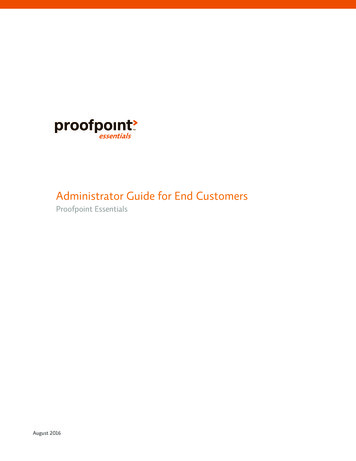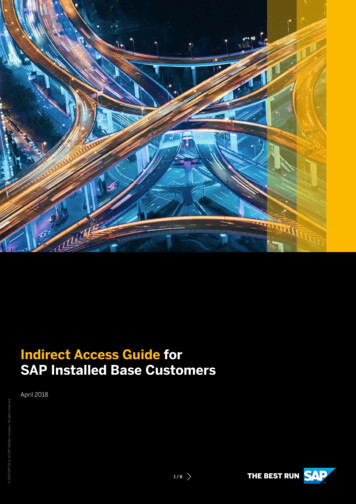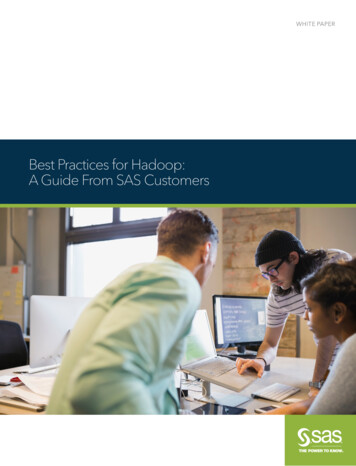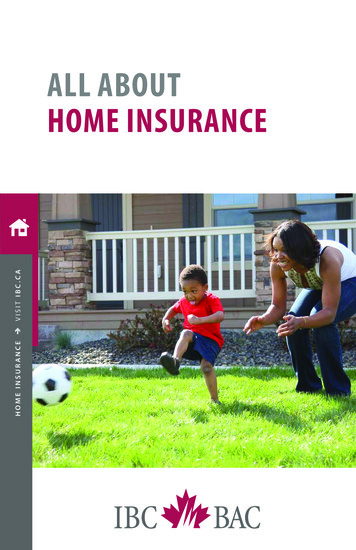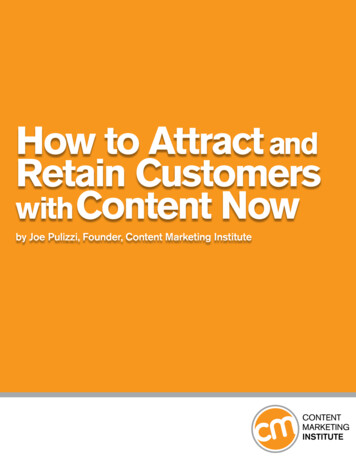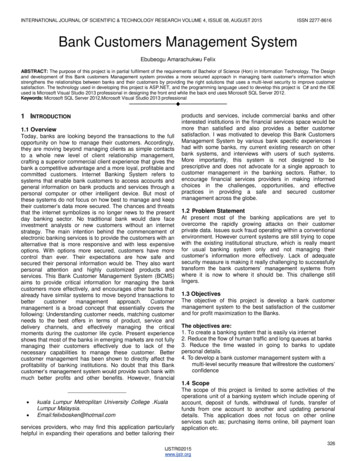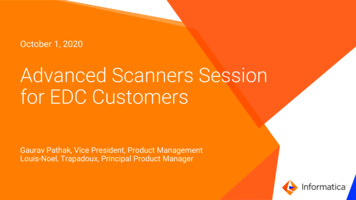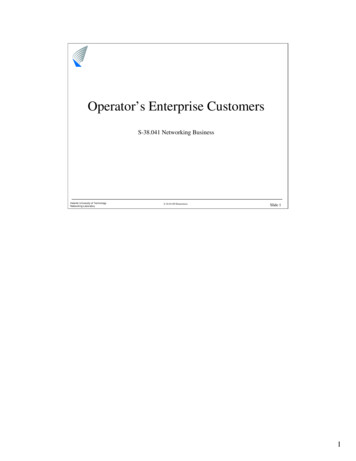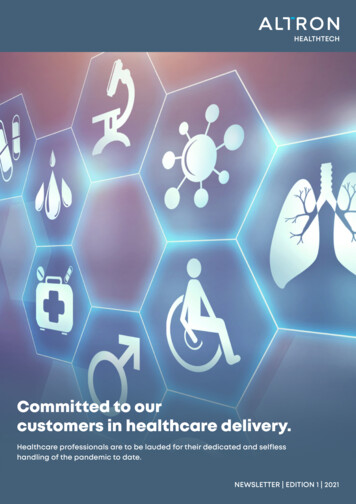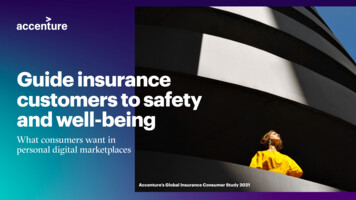
Transcription
Guide insurancecustomers to safetyand well-beingWhat consumers want inpersonal digital marketplacesGuide insurance customers to safety and well-being 1Accenture’s Global Insurance Consumer Study 2021
A mature and historically stable industry, insurance has operated on established,reliable business strategies and methods. But when digital technology reallybegan to take hold with consumers, it upended traditional insurance models.About the studyThe good news is that the same technology disruptinginsurers can be used to grow their business, ensuringrelevance and the personalized insurance experienceconsumers want.respondentsAs noted in our preview report, Three ways COVID-19 is changing insurance, ourbi-annual study of insurance consumers reveals how attitudes and behaviors areshifting—and point toward actions insurers can take.1Guide insurance customers to safety and well-being 247,81028global markets
Exploring new models of doing business—models thatcapitalize on the benefits technology can bring whilemeeting a changing set of consumer demands—willhelp insurers remain relevant and grow, particularly:Taking a fresh look at how to meet theneeds of generational segments, whohave differing views on technologyenabled insurance servicesOffering usage- and behavior-basedinsurance to better personalize and targetofferings, meeting consumer demand forbetter valueRe-evaluating the role humans play ina digital ecosystem to restore trust andbetter engage consumersGuide insurance customers to safety and well-being 3Proactively rethinking their business strategy along these vectors allows insurancecompanies an opportunity to get closer to their consumers at a time when manyshow increased willingness to consider alternative providers and methods ofpurchasing insurance (Figure 1).Figure 1. Insurance consumers go shopping.Consumers who say theyare likely to considerbuying insurance fromonline service providerslike Amazon or Google202027%2018Consumers who say theyare likely to considerbuying insurance from asupermarket/retailer22%202024%2018018%1020A uniform “indemnity model” (collect premiums and process claims if necessary)isn’t enough; our research makes it clear consumers now expect more help fromtheir insurance provider. Our three areas of action can help ensure they get it.30
ACTION #1:Accommodating varyinggenerational appetites fordigital services.Technology is a lifeline to increasingly digital insuranceconsumer segments.Digital capabilities are now essential for insurers, connecting them to an increasingly digitalconsumer. COVID-19 accelerated the transition to digital in 2020 across all demographicgroups. However, clear differences in generational appetites for digital offers emerged.Millennial and younger consumers (18 – 34) express greater interest in digital offerings thathelp them make safer, healthier, and more sustainable choices. For example, 61% of Millennialand younger consumers say they would be interested in home cybersecurity insurance wherepremiums are tied to using the latest virus protection software. Among consumers aged 55 less than half (42%) say the same.Guide insurance customers to safety and well-being 4
While the appeal of digital channels and services is higher amongyounger demographic segments, desire and preference for digitalamong older consumers is growing. Fifty-eight percent of consumersaged 55 say they would share significant data for personalizedservices to help them prevent injury and loss—an increase of24% from two years ago. Older consumers also show increasingpreference for digital claims with 71% saying they would like theinternet chat/video insurance claim process to replace the traditionalin-office claim process—an increase of 3%.Sustainability represents a win-win for insurers and Millennial andyounger consumers. Our survey shows that younger segments wantdigital experiences that encourage sustainable travel and shoppingpractices. More than two-thirds of Millennial and younger consumers(67%) consider such help appealing. By contrast, 43% of consumersaged 55 say the same (Figure 2).With younger consumers showing a stronger interest in sustainability,insurers have the opportunity for a double benefit in achievingsustainability targets. In addition to the risk management benefits,messaging related to the insurer’s sustainability efforts demonstratesto younger consumers that sustainability is a shared value.2 Insurersare already well positioned on this with 71% of Millennial and youngerconsumers saying they see their insurers delivering on ethical andsustainable business practices.Guide insurance customers to safety and well-being 5Figure 2. Younger consumers favorexperiences that encourage sustainability.55 unger67%020406080
ACTION #2:Offering consumers quidpro quo: Value for data.Personalization, per habits and behaviors,takes center stage.Consumers say they are more willing to offer personal data in exchangefor more personalized pricing, offers, and discounts. They are increasinglydemanding to be charged based on behavior and habits—and they’re willingto allow insurers to collect and use their data in exchange for that value.Consumers are being pragmatic and protective with their data, however.They say they will only share data for incentives; they show no increasedwillingness to share data without those incentives.Our study shows consumer willingness to share data in exchange forenhanced value in health-related insurance products, such as life, longterm care, and disability. Approximately 7 out of 10 consumers (69%) saythey would share significant data on their health, exercise and drivinghabits in exchange for lower prices, an increase of 19% from two yearsago. As the market value of global health and wellness is expected to riseto 1.3 trillion by 2024, an increasing number of insurers are concurrentlydeveloping behavioral insurance offerings that promote wellness.3Guide insurance customers to safety and well-being 619%more consumersnow say they wouldshare significantdata on their health,exercise, and drivinghabits in exchangefor lower pricing.
Global health and wellness company Vitality and its parent company, Discovery,won two Efma-Accenture Innovation in Insurance awards in 2020 for theirpioneering shared-value business model, which has been scaled globally to 25markets with over 20 million members.4 The program, which guides and rewardsbetter health behavior, has been adopted by leading insurance organizationsaround the world, with the aim of making people healthier. Sumitomo Life’sVitality program, for example, acquired over 450,000 members in less than twoyears, with 84% engaging in some form of exercise because of the program.5In the auto insurance space, consumers look for personalized offers in the form of usagebased or “pay-as-you-drive” auto insurance. Almost three out of four consumers (73%)express interest in this model, up from 60% just two years ago (Figure 3). Twenty-ninepercent of consumers who can drive expect to drive less in the long-term than they didbefore the pandemic. They will expect their rates and plans to reflect their new habits.Figure 3. Consumer interest in personalized pricing and service increases.Consumers2020interested in“pay-as-you2018drive” autoinsurance 073%60%255075100The right partners can help the insurer reach new customers with personalizedoffers based on behavioral data and analytics. Whether the insurer is the platformowner or the platform partner, a customer-centric experience can help driverevenue and maximize customer lifetime value.Guide insurance customers to safety and well-being 7Partnering to increaseawareness and engagementInsurers are devising innovative ways to increase awareness ofinsurance offerings and engagement with consumers, oftenpartnering to better embed themselves into people’s daily lives.In Singapore, NTUC Income and Visa have launched SNACKUP,which allows consumers to build insurance coverage when theyspend with their Visa cards. Funds are contributed in the form ofrebates from merchants and participating brands.6 Consumerscan choose to build coverage in term life, critical illness, orpersonal accident insurance—or all three.Insurance providers Marmalade and Metromile offer examples ofpersonalized, usage-based auto insurance. Both use smartphonetelematics that allow drivers to pay for insurance based on milesdriven. Metromile recently partnered with a U.S. automaker toaccess data directly and provide personalized coverage.7
ACTION #3:Restoring trust: The delicatebalance between humanand digital interaction.Figure 4. Consumer trust is down.A Human Machine model provides thebest of all worlds.30Despite consumer willingness to share data in exchange for personalization andvalue, their level of trust is down. Just under a third (32%) of consumers say they put alot of trust in their insurers to look after their data, a decrease of 8 percentage pointsfrom two years ago (Figure 4). This is not surprising, as we’ve seen the number ofcyberattacks against insurers double in the past two years.8 Although successful databreaches in the insurance industry are down 42% since 2018, insurers face both anincreasing cyber threat and a consumer trust problem.9504040%32%2010020182020Consumers who say they puta lot of trust in their insurersto look after their data.Guide insurance customers to safety and well-being 8
Beyond data breaches, 38% of consumers (45% of those aged 55 ) say they are reluctant to give up personaldata because they consider it too intrusive, up from 25% two years ago. This may be less about insurers and theirtrustworthiness and more to do with consumers’ growing concerns about maintaining control of their data.10The result is a consumer in conflict. Despite a growingconcern about data privacy and security, the consumerwants personalized pricing and service and is increasinglywilling, however reluctantly, to share data in order to get it.Achieving the right balance between digital and human interaction makes a difference. For example, whileconsumers are interacting more and more in the digital realm, particularly during COVID-19, they still view humantouchpoints as more trustworthy than digital touchpoints when they are in need. Almost half (49%) say they placea lot of trust in a human advisor in an office when making an insurance claim, while only 12% say the same ofautomated service over phone/web/email, and just 7% say the same of a chatbot.Guide insurance customers to safety and well-being 9
Humans, machines,and consumer trustThe research shows clearly that consumer trust is down. And consumers have varyinglevels of trust in humans versus machines. Strategizing on the right Human Machinemix will be key to restoring trust and offering insurance consumers the array of optionsthey want for service.Training and skilling an insurance workforce that works well with digital tools willbe essential for success. Insurance can be an emotionally complex businessfor consumers—they need the freedom to choose methods of interaction mostcomfortable for them. Those methods may change depending on the type ofinteraction they require at any given moment. Context matters more than ever whenpersonalizing service.Magnitude of risk also matters. A Millennial or GenZ customer buying a small renter’spolicy online may do so because it’s a low-risk proposition, but someone buying home,auto, and umbrella policies in a bundle may desire more human advice.Guide insurance customers to safety and well-being 10
A 360-degree view of each customer needs to be available sonext-best-actions and suggestions are on target. That can onlybe provided through comprehensive, integrated front- and backoffice digital capabilities. A digitally enabled human provides thebest of both worlds and can help grow customer trust.Overall, consumers open insurance accounts and interact with their insurer via mobile and online channels much more frequently thantwo years ago. For example, 37% contact their insurer via a mobile app or website at least once a month. Two years ago, just 23% did.There’s a perceived trade-off between convenience and trust. If insurers can show consumers there doesn’t have to be, it will go a longway toward enhancing the relationship.While some of the increased online activity was forced due to lockdowns, we don’t expect any significant decrease in digital engagement. Whenasked how they would ideally like to open a new account or product with a new insurer—something typically in the past done in-person—48% ofconsumers say online via their desktop or laptop, and 34% say online via a mobile app or website.Guide insurance customers to safety and well-being 11
What matters toyour insurancecustomer?There’s no doubt that the effects oftechnology are disruptive. But insurers canharness that disruption to better connectwith consumers for positive business impact.New models of doing business that capitalizeon how technology helps insurers meetchanging consumer demands are essential.Consider with your team how those modelsmay be applied based on your existing bookof business and unique market positioning.Focusing on the insurance lines where your business has competitive advantage, investstrategically in digital capabilities to meet the needs of key generational segments. Thoseinvestments may include new relationships with insurtechs or adjacent industry players.Knowing consumers expect value in exchange for their data, re-invent usage- and behaviorbased insurance offerings for greater personalization. Decide in which instances you needto be the platform owner and when you might better perform as the platform partner.And cultivate data and analytics capabilities that would integrate personalized pricing andincentives into holistic loss prevention, mitigation, and restoration offers.Finally, with consumer trust trending downward, re-evaluate the need for human touch inyour digital services. The right mix of Human Machine can help reverse the consumer trusttrend and better engage customers. If your business relies on agents as a distribution channel,consider how you can enable their personal connections with customers and prospects in digitalchannels. Explore the strategic opportunities in intelligent data signals, dynamic personalizedcontent, social engagement, and automated marketing capabilities that support an always-onagent/customer relationship.Delivering in a digital world, on-demand, while achieving that critical balance between human touchand the ease of technology is both art and science. Every day our team helps insurers retain theirrelevance in consumers’ lives and position themselves for growth in this new risk landscape. We wouldappreciate the opportunity to talk with your team about how to better connect with your customers.Guide insurance customers to safety and well-being 12
AuthorsReferencesKenneth SaldanhaGlobal Lead - Insurance,AccentureTodd Staehle1All data cited come from Accenture’s bi-annual global study ofinsurance consumers unless otherwise noted.2“Act now to become a sustainable insurer,” Accenture Insurance Blog(November 27, 2020).3Technavio, Accenture COVID-19 Consumer Research (2020).4“Efma-Accenture Innovation in Insurance Awards,” Accenture (June 17,2020).5“Discovery annual report, audited results for the year ended June 30,2020,” (p.75)6“Spend on your card to build free insurance cover, a new way ofgetting protection,” Life Insurance International (December 14, 2020).Insurance Lead - Interactive,AccentureContributorsAndre SchliekerGlobal Insurance Research LeadAccenture a MeccaInsurance Survey Research LeadAccenture Researchmariafrancesca.mecca@accenture.com7“Say hello to connected car insurance,” Metromile (2021)8“Cybersecurity at a premium,” Accenture (July 10, 2020).9Ibid.“Americans and Privacy: Concerned, Confused and Feeling Lackof Control Over Their Personal Information,” Pew Research Center(November 15, 2019).10About AccentureAccenture is a global professional services company with leadingcapabilities in digital, cloud and security. Combining unmatchedexperience and specialized skills across more than 40 industries,we offer Strategy and Consulting, Interactive, Technology andOperations services—all powered by the world’s largest networkof Advanced Technology and Intelligent Operations centers. Our514,000 people deliver on the promise of technology and humaningenuity every day, serving clients in more than 120 countries. Weembrace the power of change to create value and shared successfor our clients, people, shareholders, partners and communities. Visitus at www.accenture.com.Accenture ResearchAccenture Research shapes trends and creates data-driveninsights about the most pressing issues global organizations face.Combining the power of innovative research techniques with a deepunderstanding of our clients’ industries, our team of 300 researchersand analysts spans 20 countries and publishes hundreds of reportarticles and points of view every year. Our thought-provokingresearch—supported by proprietary data and partnerships withleading organizations such as MIT and HBS—guides our innovationsand allows us to transform theories and fresh ideas into real-worldsolutions for our clients. Visit us at www.accenture.com/research.Gabe SchmittleinResearch AnalystAccenture r: This content is provided for general information purposes and is notintended to be used in place of consultation with our professional advisors.Copyright 2021 Accenture. All rights reserved.Accenture and its logo are registered trademarks of Accenture.Guide insurance customers to safety and well-being 13This document refers to marks owned by third parties. All such third-party marks arethe property of their respective owners. No sponsorship, endorsement or approvalof this content by the owners of such marks is intended, expressed or implied.
Accenture’s Global Insurance Consumer Study 2021 What consumers want in . digital experiences that encourage sustainable travel and shopping practices. More than two-thirds of Millennial and younger consumers . policy online may do so beca
